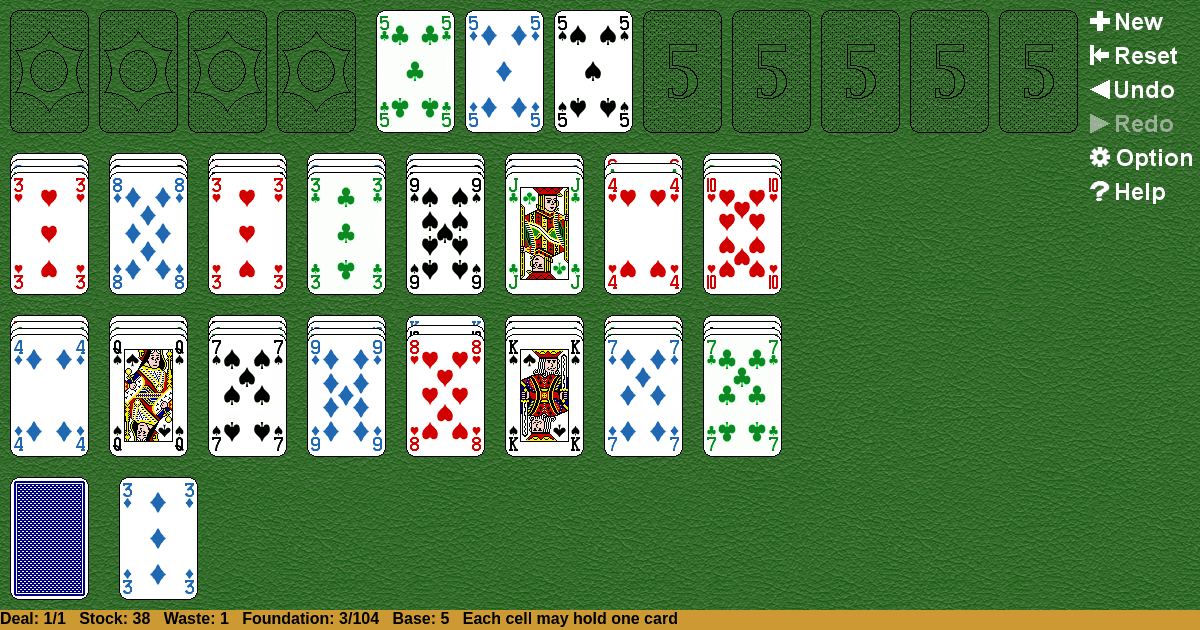Skippy
Home |
How to play |
FAQ |
About
How to play Skippy?
Game Objective:
The primary goal in Skippy Solitaire is to move all cards from the tableau to the foundations, building each foundation according to specific rank-based rules until the entire deck is cleared from the tableau.
Setup & Layout:
- Deck: Use a standard 52-card deck.
- Tableau: Deal 16 tableau piles with 4 cards each, all cards dealt face-up.
- Foundations: There are 4 foundation piles. At the start, a random card is dealt to the first foundation pile; this card sets the base rank for all foundations.
- Cells (if present): Some versions include 4 cells (storage locations), each holding a single card.
- Stock/Reserve: There is no stock or reserve in traditional Skippy Solitaire; all cards are in the tableau and foundations at the start.
Key Play Areas:
- Tableau: The main area with 16 piles, each containing 4 face-up cards.
- Foundations: Four piles, each to be built up in suit starting from the base rank.
- Cells (optional): Temporary storage for single cards (not always present in every version).
Skippy Solitaire Rules:
Foundation Building:
The first foundation pile starts with a random base card (e.g., 7♣).
All other foundations must also start with a card of the same rank (e.g., all 7s).
Foundations are built up in suit, wrapping from King to Ace if necessary, until each pile contains all 13 cards of that suit, starting from the base rank.
Tableau Building:
Cards in the tableau are built down in rank, regardless of suit (e.g., 9 on 10, 8 on 9).
Only single cards may be moved at a time (sequences cannot be moved as a group).
Empty tableau spaces may be filled with any card.
Cells (if included):
Each cell can hold only one card.
Cards may be moved from cells back to the tableau or to the foundations.
Gameplay:
Player Actions:
Move a single card from one tableau pile to another, building down in rank (any suit).
Move a single card from the tableau or a cell to a foundation, if it matches the next required card in the sequence.
Move a single card to an empty tableau pile or cell (if available).
Move a card from a cell back to the tableau or to a foundation.
Introducing New Cards:
There is no stock; all cards are available from the outset.
The only way new cards become available is by uncovering them through moves within the tableau.
No More Legal Moves:
If no cards can be moved to either the foundations or within the tableau/cells, the game is blocked and ends.
Winning & Losing Conditions:
- Winning: The game is won when all cards from the tableau have been moved to the foundations, completing each foundation pile in sequence from the base rank through all 13 cards of its suit.
- Losing: The game is lost (unwinnable) if no legal moves remain and not all cards have been moved to the foundations.
Special Rules & Edge Cases:
- Filling Empty Tableau Spaces: Any card may be moved to fill an empty tableau pile.
- Foundation Wrapping: When building foundations, if the base card is not an Ace, the sequence wraps from King to Ace as needed (e.g., if the base is 7, the sequence is 7, 8, …, King, Ace, 2, …, 6).
- Cells (if present): Only one card per cell; cards in cells can be played to tableau or foundation at any time.
- No Sequence Moves: Only single cards may be moved at a time; you cannot move a group of cards as a sequence.
- No Stock or Redeal: All cards are in play from the start; there is no stock, reserve, or redeal.
Summary of Unique Mechanics:
- All cards dealt face-up in the tableau.
- Random base card determines the starting rank for all foundations.
- Foundations built up in suit, wrapping as needed.
- Tableau built down in rank, regardless of suit.
- Only single-card moves allowed.
- No stock or redeal; all play is from tableau and foundations.
These rules distinguish Skippy Solitaire from other solitaire variants and define its unique gameplay structure.




























































